In suspension
When bass get in the middle of the water column, a drop-shot rig can be key
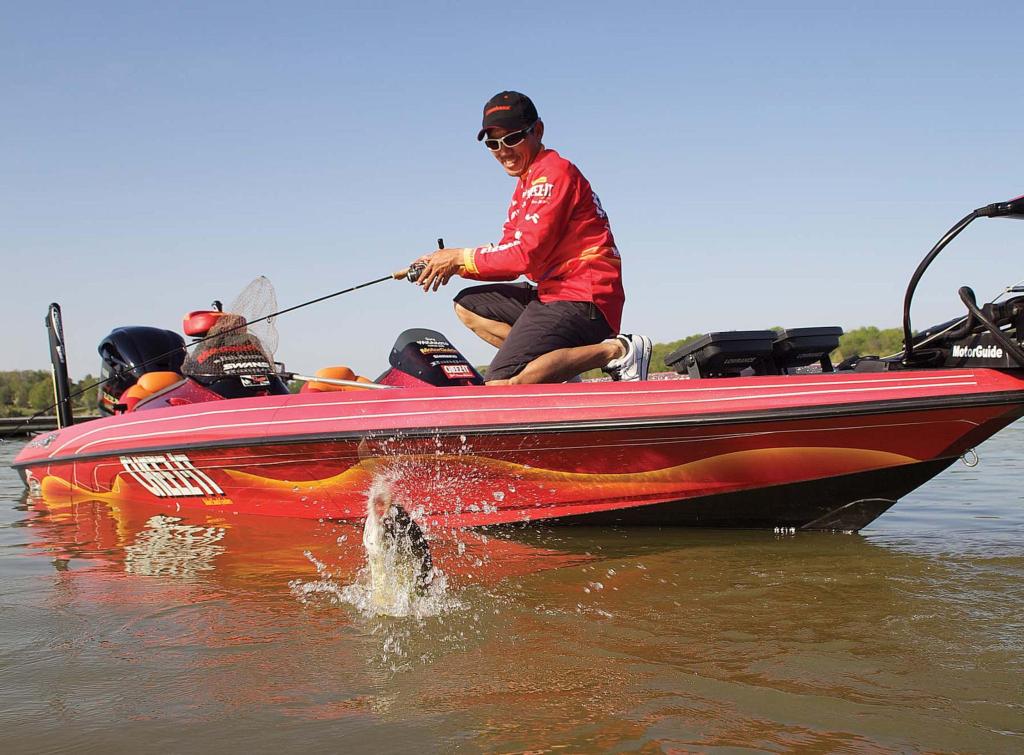
Editor’s note: Bass can suspend at different points throughout the season depending on location, fishery and other factors, but fall and winter are prime times for suspending fish, so this article from FLW Outdoors Magazine is timely.
——————————————-
Suspended bass – whether largemouths, smallmouths or spots – are notoriously difficult to catch. They’re among the most finicky and flighty targets an angler can pursue. In fact, confronted with suspended fish as the primary pattern, most anglers punt and look for a secondary pattern. That’s not always the best option; just consider what happened in August 2010.
That month, pro Kevin Hawk of Guntersville, Ala., targeted suspended bass to win the Forrest Wood Cup and its $600,000 top prize on Georgia’s Lake Lanier. Three weeks later, Cheez-It pro Shinichi Fukae of Palestine, Texas, who finished 49th at Lanier, took home more than $50,000 in cash and prizes by winning the FLW Series Eastern Division event on Lake Champlain – also by targeting suspended fish.
They were two very different tournaments – Lanier was a struggle, and Champlain was a whackfest; the former involved mostly spotted bass, and the latter involved mostly smallies. But in both cases a drop-shot presented to suspended bass was the ticket to the winner’s circle.
Such an approach is grounded in logic. A drop-shot can be dangled tantalizingly in front of suspended bass right at eye level. Yet the rig also can be ripped and snapped to draw reaction bites. In fact, in terms of duping suspended bass to bite, no offering is more versatile.
Suspended bass basics
The first step in targeting suspended bass is deciding if, indeed, they are suspending. According to Fukae and Hawk, such behavior occurs most often from late summer into early fall, when fish are offshore, the water is hot, the current subsides and baitfish schools are roaming away from the bank. Either angler typically looks for this pattern on clear, deep bodies of water, especially where bait is known for wandering in open-water schools (that’s why advanced research is occasionally your best tool in the search). Obviously, Lanier and Champlain fall into this category, as well as lakes such as Beaver, Table Rock and Erie.
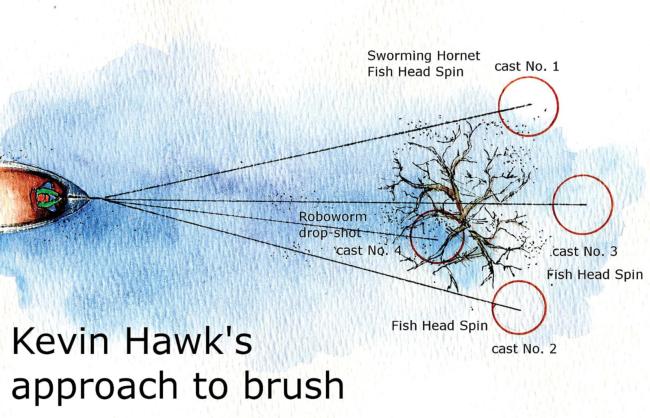
Locating suspended fish in those thousands of acres of water starts with your electronics and understanding the seasonal patterns of the baitfish bass feed upon. On Lanier, that means blueback herring. Before the Forrest Wood Cup, Hawk spent an extensive practice period searching for the herring and trying to piece together the puzzle of how they related to the available cover, because he knew the bass would follow them. In his native California, the bait, and the bass, often suspend around large boulders. In Georgia, he found that man-made brush piles replaced the big rocks as the holding stations for the prey. So his search began with locating brush piles, rather than bass, with his electronics.
A vertical drop-shot presentation is most effective at depths of about 15 to 70 feet, depending on the lake and conditions. Once suspended fish are detected, they usually can be patterned. Even if the depth of the water column varies from one productive area to the next, the depth at which the fish hold might not.
For example, on one of the tournament days at Lanier, Hawk’s first fish let him know that the fish most willing to bite were at the 22-foot depth. That’s where he targeted the fish the remainder of the day – on every spot, no matter the distance to the bottom.
Other times, you start by locating a major structure feature and then search the water above it or out parallel to it – bass often suspend parallel to the edge of a drop-off. Most of Fukae’s fish at Champlain came in 30 to 40 feet of water. He didn’t rely on brush piles like Hawk did, but his fish weren’t out in the open, either. He marked humps, breaks and other structural elements that held fish; it’s just that the bass weren’t pinned to the bottom. Fukae also relied on the presence of baitfish to determine if a spot was worth a stop. No perch or other baitfish on his graph and he usually wouldn’t even deploy the trolling motor.
Fukae was looking for classic summering spots for transient smallmouths, eventually putting together a milk run. Each day he had to relocate them, largely through the process of elimination. There wasn’t necessarily a rhyme or reason that he could discern as to where they’d move. But he knew where the structure was located and that the fish would be somewhere in relationship to it.
Making them bite
To make the proper presentation, boat positioning is the first step and is based on the depth of the fish. Hawk will put the boat nearly right on top of his quarry, even in water as shallow as 15 feet, but usually not before making a few casts with a Sworming Hornet Fish Head Spin. He wants to pick off the aggressive feeders first, if possible. If he knows that the fish are suspended deeper – say 40 or 50 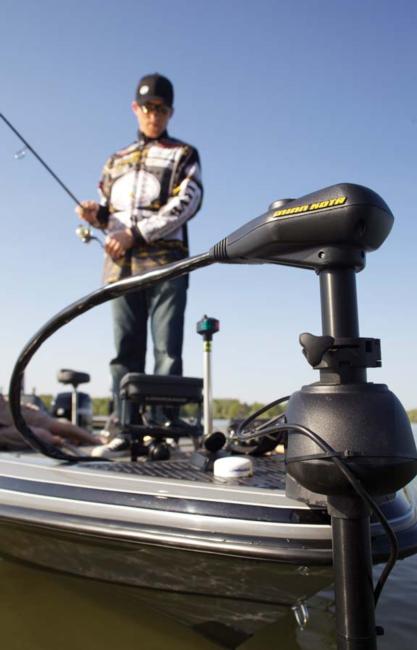 feet – he’ll head straight for the meat of the spot, immediately placing the boat right on top of them. He fishes for them with his electronics, watching the actual strike occur like a video game.
feet – he’ll head straight for the meat of the spot, immediately placing the boat right on top of them. He fishes for them with his electronics, watching the actual strike occur like a video game.
“I’d be looking at my graph the entire time, looking for fish,” Hawk says. “I’d drop a drop-shot right in front of the brush pile. Then I’d do one more drop right into the heart of it because if they’re tight, you can’t distinguish them on your graph. Then I’d move on to the next one.”
In most situations, you want to put the lure directly in front of the fish’s face and force it to bite, and that can best be achieved by watching the lure descend on your graph. Too high or too low and you usually won’t get them to move, but placed right in their face and often they can’t resist. It comes back to numbers and efficiency – trying to force an inactive fish to chase isn’t a wise use of time.
This vertical approach is more efficient than casting a drop-shot because it ensures a direct presentation above the fish and can be done much more quickly and accurately. In fact, even when Hawk did “cast” his drop-shot from out in front of the brush piles at Lanier, he was rarely making more than 5- or 10-foot pitches.
The next step is getting the fish to bite, but it’s not the subtle shake and twitch you might expect.
“I’m trying to cause a reaction bite,” Hawk says. “You’ll see one on the graph follow your lure down and hopefully he bites it. When I engage the bail [after the lure falls], if I’m not bit I shake the rod violently.”
That often encourages a fish that has followed the lure downward to strike. If it doesn’t happen quickly, Hawk will pull up stakes and head for the next spot. There’s no precise way to gauge why the fish aren’t in a feeding mood, but this game is about making as many fresh drops as possible.
“You can’t tell from your electronics whether they’re going to bite or not,” Hawk says. “Even if I see good fish on the graph I rarely make more than a half-dozen drops before I cut my losses and leave. They might just not be feeding at that point, so I can come back later.”
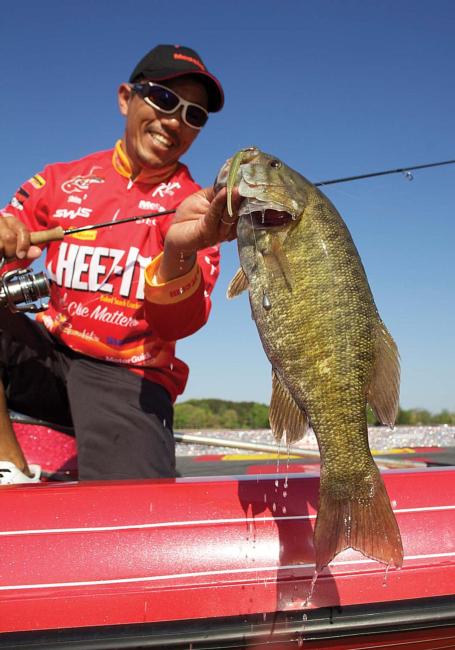
Fukae agrees: “If I can catch one of them, I’ll usually stay there for a while and try to catch another one. If not, I won’t stay there long. I tend to move quickly when fishing this way.”
Efficient drop-shot gear
A drop-shot is preferable to other vertical lures, such as a shaky head or spoon, when the fish are packed most closely together. Success hinges on dropping the lure right on the bull’s-eye.
The rest of your gear should be chosen with efficiency in mind as well.
A fast reel is critical. With a speedy gear ratio, not only can you make more drops, especially in deep water, but you can get a fish up and out of brush piles quickly. A fast reel also gives you the slim chance to catch more than one fish from a given stop.
“Usually you can’t do that because when you catch one, the whole school comes up with it,” Hawk says. “Then you have to give them 15 minutes to an hour to reset. Ninety-five percent of the time it’s a one-fish deal.”
Fukae and Hawk both use long spinning rods – at least 6 feet, 10 inches – for vertical drop-shotting.
“You want to use a soft rod,” Fukae adds. “It performs like a drag works on the reel, reducing line breakage.”
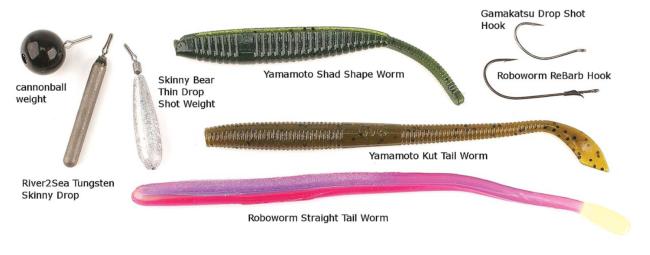
The rig itself can be customized for any situation. Hawk’s dropper varies anywhere from 1 inch to a few feet long, although he rarely goes shorter than 6 inches. His rule is that if they aren’t biting it, lengthen the dropper.
Hawk typically pairs his worm with a 1/0 Roboworm ReBarb hook and Texas-rigs it. Fukae prefers a Yamamoto Shad Shape Worm or Kut Tail paired with a Gamakatsu Octopus or Drop Shot Hook. If heavier cover is close by, he’ll use a Gamakatsu EWG instead.
At Lanier, Hawk employed a 3/8-ounce weight, far heavier than most of the competition used, in order to force a reaction strike. He prefers the Skinny Bear Thin Drop Shot Weight, which he said comes through cover particularly well. Fukae used only a 1/4- or 3/8-ounce weight for his Champlain win, despite the fact that he was fishing deeper than most of the competition. Given his combination of a sensitive rod and limited-stretch fluorocarbon, he felt that those weights maximized drop speed without sacrificing the natural appearance of the worm.
If bank-beating is your game, finding suspended bass over cover might not be worth the time and effort it takes to figure them out. But if you like winning tournaments it’s a critical pattern to understand. Once you figure out where they live, more often than not a drop-shot is the best way to get these misunderstood fish to bite.